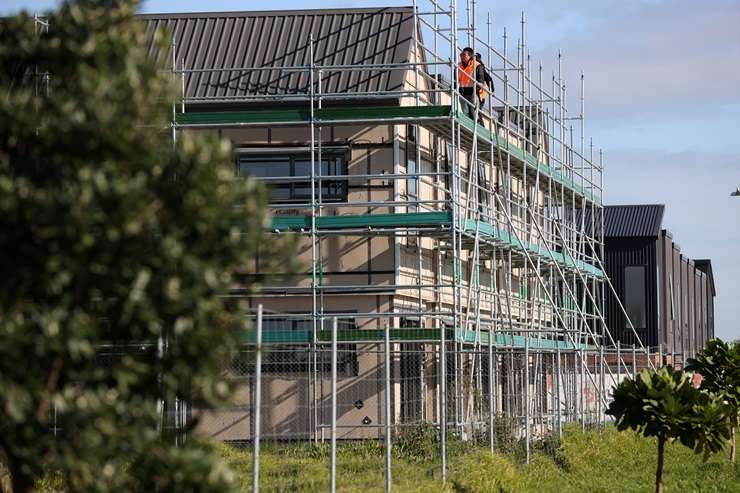A new report from BNZ’s economics team has suggested that Kiwis would be better off financially buying an existing home than building a new one.
BNZ chief economist Mike Jones said residential construction costs have increased sharply at the same time as steep falls in house prices.
He warned that New Zealand was in danger of once again underbuilding, noting that residential construction activity was set to fall further “despite strong population growth”.
The BNZ report predicted that the cost gap between building new and buying an existing home would narrow as a result of stabilising construction costs and improved market conditions putting upwards pressure on house prices.
Start your property search
Read more:
- Zuru Toys billionaire pays $24m-plus for Herne Bay bowler
- Sir John Key's former beach house up for grabs
- Revealed: Where council rates are hurting the bottom line
Jones said in the report that “nailing down one all-encompassing measure of build costs is nigh on impossible given all the variables in play such as size, location, complexity, and spec”.
“One thing that is clear though is that it’s become significantly more expensive to build relative to the situation only a few years ago. And that’s even before you factor in land costs. Depending on the measure you look at, construction costs have surged 35-45% over the past three years,” he said.
Based on the most recent consenting figures, the average build cost in New Zealand was just over $3200 per sqm, up from $2200 per sqm in 2020.
“If you add everything up, and you aggregate everything up to a macro level, you’re looking at a cost of build now that is really high. Not just in an absolute sense, but relative to a home that an individual might be able to get in the existing market,” said Jones. “So, the incentive to build is quite low from a financial perspective.”

BNZ chief economist Mike Jones: "Depending on the measure you look at, construction costs have surged 35-45% over the past three years." Photo / Fiona Goodall
The BNZ report compared build costs to the nationwide median sale price of existing homes. According to REINZ figures, the cost of an existing home has dropped from a 2021 peak of nearly $900,000 to $785,000 now.
“The almost $200,000 difference between building and buying is around the widest ever on our numbers, and about three times the long-run average,” Jones said in his report.
One issue making like for like comparisons difficult, Jones said, was that new homes were getting smaller. The average new home in 2023 is around 140sqm, down from the long-term average of 190sqm. For standalone homes the average is now 190sqm, compared to the 215sqm long-term average.
Even with smaller builds, the cost of a new home is $100,000 more expensive than 2020 levels. The total cost for an average new-build is now $450,000 – up from $350,000. For standalone homes the increase has been $160,000 to $600,000 over the same period.
The number of dwelling consents has fallen sharply over the past year, in response to higher interest rates, a weaker housing market and sharp rises in building costs. In September new dwelling consents were down 37% year-on-year.
The BNZ data for building costs is based on consents, not Code Compliance Certificate issuance at the end of the build.

The cost of a new-build, according to BNZ's new report, is $3200 per sqm. Photo / Fiona Goodall
In terms of completed homes, which is always fewer than the numbers consented, Auckland Council’s most recent update of Code Compliance Certificates issued for new homes when they are completed peaked in June 2023 at 1742 for the month. That fell away to 1557 in July and 1497 in August.
Separate data for new-build sale prices from CoreLogic mirror the points made in the BNZ report.
CoreLogic chief economist Kelvin Davidson said: “With three-bedroom houses the current new-build premium is $64,000, based on sale prices. That has trended up gently over the past 18 months. If you go back [18 months] it was more like $50,000. For four-bedroom properties it’s $125,000 currently, which had drifted higher in the past year.”
He said he had heard anecdotal evidence of people who signed up for off-the-plan houses in 2021 walking away from those builds. “You might have put down 50 grand, but in the meantime, the general market has fallen. You might actually be better off to walk away from the deposit and buy another place $150,000 cheaper,” he said.
Davidson noted recent spikes in migration underscored the need for more housing. “There are still new houses hitting the ground right now but the problem might be in six or 12 months time when there’s nothing new coming in. That’s when you might see the supply crunch happening. There’s definitely a risk,” he said.

CoreLogic chief economist Kelvin Davidson: "The concept of a housing shortage is a little bit of a tricky one." Photo / Peter Meecham
Davidson didn’t believe the building industry would be hollowed out in the same way it was after the GFC. “That set us up for shortages of housing over the following decade,” he said.
The change in government, however, could adversely impact construction. Davidson said current loan to value ratio [LVR] restrictions incentivise new-builds as do the tax rule introduced by the previous government that limit mortgage interest deductibility by investors for all residential rental properties except new-builds. National has said it would roll those rules back. “All things equal there is a growing risk that [home] shortages re-emerge.”
He added: “The concept of a housing shortage is a little bit of a tricky one, because those 100,000 new immigrants in net terms are already in the country, and are living somewhere. That might involve more people per house than might be ideal. Ideally, society would want fewer people per house, and have more houses available for people to buy at affordable prices. If we do see the construction industry continue to slow, without supply, people will be bunching up.”
- Click here to find properties for sale


















































































